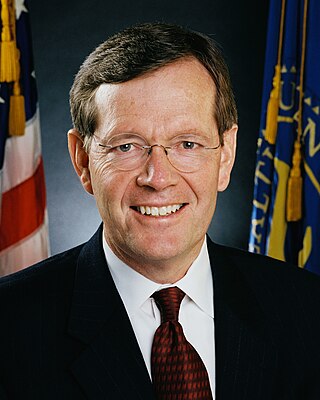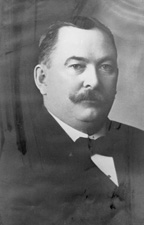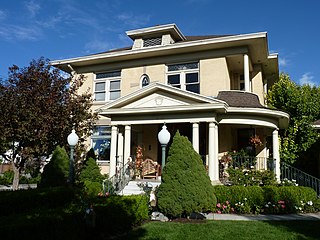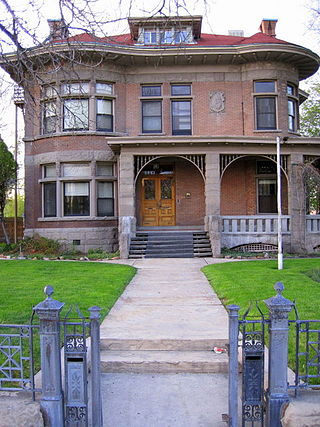
Michael Okerlund Leavitt is an American Republican Party politician who served as the 14th governor of Utah from 1993 to 2003, and in the George W. Bush administration as Administrator of the Environmental Protection Agency (EPA) from 2003 to 2005 and as Secretary of Health and Human Services (HHS) from 2005 to 2009.

Capitol Hill in Salt Lake City gets its name from the Utah State Capitol prominently overlooking downtown, it is a neighborhood in Salt Lake City.

The Alfred McCune Home is one of the mansions on Capitol Hill in Salt Lake City, Utah, from around the turn of the 20th century. Built for Alfred W. McCune on the inclined south side of Capitol Hill at the northeast corner of 200 North Main Street, the mansion has 21 rooms and is on the National Register of Historic Places.

Salt Lake City, Utah has many historic and notable sites within its immediate borders. Although the entire Salt Lake City metropolitan area is often referred to as "Salt Lake City", this article is concerned only with the buildings and sites within the official city limits of Salt Lake City.

The Beehive House was one of the official residences of Brigham Young, the second President of the Church of Jesus Christ of Latter-day Saints, in Salt Lake City, Utah, United States. The Beehive House gets its name from the beehive sculpture atop the house.

Thomas Kearns was an American mining, banking, railroad, and newspaper magnate. He was a US Senator from Utah from 1901 to 1905. Unlike the predominantly Mormon constituents of his state, Senator Kearns was Catholic.

Harriet Amelia Folsom Young was a pioneer and an early member of the Church of Jesus Christ of Latter-day Saints, as well as a cultural and political figure in Salt Lake City, Utah. An accomplished pianist and vocalist, Folsom was the fifty-first plural wife of Brigham Young, who served as the church's second president.

The Brigham Young Complex is a collection of buildings historically associated with the second President and leader of the LDS Church Brigham Young, on East South Temple in the center of Salt Lake City, Utah.

John W. Gallivan was an American newspaper publisher, cable television pioneer, and civic leader. A major figure in the promotion and development of Salt Lake City and Utah's ski industry, he was instrumental in starting the campaign to bring the 2002 Olympic Winter Games to Salt Lake City. Using his position as publisher of the Salt Lake Tribune, "Jack" Gallivan was the driving force behind numerous civic improvement and development projects including the Salt Palace, the Salt Lake Arts Center, Symphony Hall, The Capitol Theatre, and the promotion of light rail. His many contributions to the economic and cultural life of the city were recognized by the community in the naming of the John W. Gallivan Plaza near the center of downtown.

Alfred William McCune was an American railroad builder, mine operator, and politician from the state of Utah. Owner of several retail and construction businesses, he helped build the Montana Central Railway and a portion of the Utah Southern Railroad, founded the Utah and Pacific Railroad, and built railways in Peru, among other projects. He also owned many profitable mines in Canada, Montana, Peru, and Utah, including the Payne Mine—which paid the most dividends in the history of British Columbia. Late in life, he co-founded the Cerro de Pasco Investment Company, which became the largest copper investor in South America and the largest American investor in Peru until it was nationalized in 1974. He was one of Utah's first millionaires.

The South Temple Historic District is a 119-acre (48 ha) historic district that was the first to be listed in the Salt Lake City Register in 1976, and was listed on the National Register of Historic Places in 1982.
Carl Martel Neuhausen was an American architect based in Salt Lake City, Utah. He designed a number of buildings that survive and are listed on the U.S. National Register of Historic Places.
Richard Karl August Kletting was an influential architect in Utah. He designed many well-known buildings, including the Utah State Capitol, the Enos Wall Mansion, the original Salt Palace, and the original Saltair Resort Pavilion. His design for the Utah State Capitol was chosen over 40 competing designs. A number of his buildings survive and are listed on the U.S. National Register of Historic Places including many in University of Utah Circle and in the Salt Lake City Warehouse District.

The Knight–Mangum House is a historic house located in Provo, Utah, United States. It is listed on the National Register of Historic Places. The mansion was built in the old English Tudor style, completed in 1908. It was built for Mr. W. Lester Mangum and his wife Jennie Knight Mangum. Mrs. Mangum was the daughter of the famous Utah mining man, Jesse Knight. The lot was purchased for $3,500 and the home was built at a cost of about $40,000. The Mangum family was able to afford the home due to the fact that they had sold their shares in Jesse Knight's mine located in Tintic, Utah, for eight dollars a share. They had purchased the shares for only twenty cents a share, so the excess allowed them enough funds to purchase the home. The contractors for the home were the Alexandis Brothers of Provo.

The Thomas N. Taylor House is a historic house located at 342 North 500 West in Provo, Utah. It is listed on the National Register of Historic Places.

The Devereaux House in Salt Lake City, Utah, United States, also known as the Staines-Jennings Mansion, was built in 1857 for William Staines. It was designed by William Paul. The house was expanded by William Jennings, mayor of Salt Lake City from 1882 to 1885, again using Paul as the architect. Devereaux was a social center for the Salt Lake City area, hosting distinguished visitors. Brigham Young's son Joseph Angell Young owned the house for a short time.

The Albert Fisher Mansion and Carriage House, at 1206 West 200 South in Salt Lake City, Utah, United States, was designed by architect Richard K.A. Kletting and was built in 1893. It was listed on the National Register of Historic Places in 2008.

The David Keith Mansion and Carriage House, at 529 East South Temple Street in Salt Lake City, Utah, United States, was built during 1898–1900. It was designed by architect Frederick Albert Hale. Keith lived in the home until 1916 when it was sold, and died in 1918. Among other activities, Keith financed and published The Salt Lake Tribune.

Kearns-Saint Ann School is a Catholic school for preschool to eighth grade students, located in South Salt Lake, Utah. Founded as St. Ann's Orphanage in 1891, it became a parochial school in 1955. The historical school building, completed in 1899, was gifted by Jennie Judge Kearns, wife of mining magnate Thomas Kearns, for whom it is named.
Norma Louise Matheson was an American politician, political strategist, activist, and conservationist who served as the First Lady of Utah from 1977 until 1985. Matheson, the wife of former Governor Scott M. Matheson, was considered a pioneer for women in Utah politics and the matriarch of the Matheson political family. Her prominent role in state politics earned her the nickname "godmother" of the Utah Democratic Party.





















